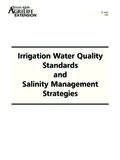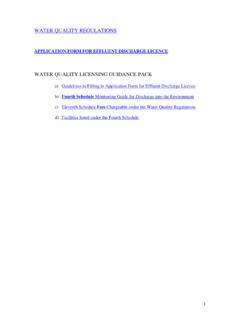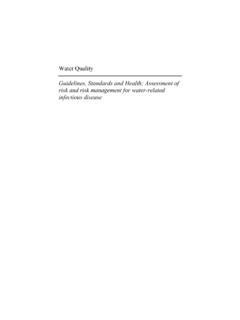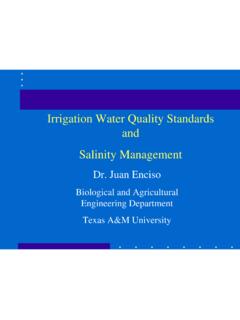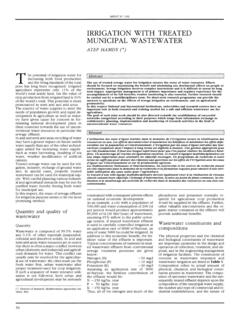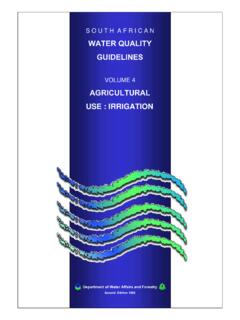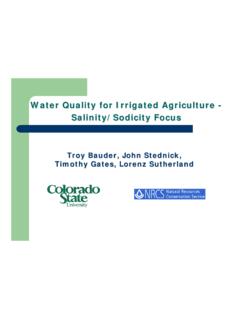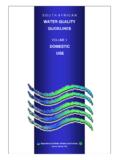Transcription of NEW JERSEY IRRIGATION GUIDE - Home | NRCS
1 June 2005 NEW JERSEY IRRIGATION GUIDE United States Department of Agriculture Natural Resources Conservation Service Somerset, New JERSEY June 2005 Acknowledgment This update of the September 1983 New JERSEY IRRIGATION GUIDE was prepared by the New JERSEY IRRIGATION water Management Specialists, MaryBeth Sorrentino and Rub n P rez. It has been formatted for compatibility with the NRCS National Engineering Handbook, Part 652, IRRIGATION GUIDE . This update contains several tables of original work including Net IRRIGATION water Requirements for New JERSEY crops and Crop Consumptive Use and Peak ET values. Cover Photo by Mar a M. Collazo, Resource Conservationist The Department of Agriculture (USDA) prohibits discrimination in all of its programs and activities on the basis of race, color, national origin, sex, religion, age, disability, political beliefs, sexual orientation, and marital or family status.
2 (Not all prohibited bases apply to all programs.) Persons with disabilities who require alternate means for communication of program information (Braille, large print, audiotapes, etc) should contact USDA s TARGET Center at (202) 720-2600 (voice and TDD). To file a complaint of discrimination write USDA, Director, Office of Civil Rights, Room 326-W, Whitten Building, 14th and Independence Avenue, SW, Washington, DC 20250-9410 or call (202) 720-5964 (voice or TDD). USDA is an equal opportunity provider and employer. NEW JERSEY IRRIGATION GUIDE CONTENTS Contents: Chapter 1 Introduction (page_5) a) General Information b) Considerations c) IRRIGATION System Plan Chapter 2 Soils (page_8) a) water Holding Capacity b) water Intake Rate c) water Application Rates d) Available water Capacity e) Erosion Control f) Information for Design Purposes Chapter 3 Crops (page_21) a) Critical Growth Periods b) Salinity Tolerance c)
3 IRRIGATION -Related Management Factors Chapter 4 water Requirements (page_29) a) Crop Evapotranspiration b) Net IRRIGATION water Requirements c) Management Allowed Soil- water Depletion d) Auxiliary water Requirements e) water Requirements for Soil- water Budget/Balance Analysis f) water Sources Chapter 5 IRRIGATION Method Selection (page_49) a) General b) Methods and Systems to Apply IRRIGATION water c) Site Conditions d) Selection of IRRIGATION Method and System e) Adaptability and Limitations of IRRIGATION Methods and Systems Chapter 6 IRRIGATION System Design (page_60) a) General b) Sprinkler IRRIGATION Systems c) Sprinkler System Design d) Micro IRRIGATION Systems e) Microirrigation System Design Chapter 7 Farm Distribution Systems (page_119) a) Pipeline Delivery Systems b) Open Ditches c) water Control Structures d) water Management e) Tailwater Recovery Systems (container nursery) f) Pumping Plant Chapter 8 Project and Farm IRRIGATION Requirements (page_131) Chapter 9 IRRIGATION water Management (page_133) a) General b) IRRIGATION water Management Concepts c) Soil-Plant- water Balance d) IRRIGATION Scheduling e) IRRIGATION System Evaluation Chapter 10 Conservation Management Systems and IRRIGATION Planning (page_168) a) General b) The Planning Process c) IRRIGATION water Management Plan d)
4 Planning Aids Chapter 11 Economic Evaluations (page_171) Chapter 12 Energy Use and Conservation (page_174) Chapter 13 quality of water Supply (page_176) a) General b) water quality Chapter 14 Environmental Concerns (page_182) Chapter 15 Tools and Worksheets (page_184) Chapter 16 Special Use Tables, Charts, and Conversions (page_230)Chapter 17 Glossary and References (page_233) Chapter 1 Introduction Contents a) General Information b) Considerations c) IRRIGATION System Plan Chapter 1 Introduction Part 652 IRRIGATION GUIDE (210-vi-NEH 652, IG Amend.
5 NJ1, 06/2005) NJ1-1 Introduction a) General Information The New JERSEY supplement to the National Engineering Handbook (NEH), Part 652, IRRIGATION GUIDE , has been adapted from the original New JERSEY IRRIGATION GUIDE . The material was developed to assist New JERSEY NRCS field personnel and others working with New JERSEY irrigators to provide general planning, design, and management guidance on various methods of IRRIGATION commonly used in the State. When the system is designed, installed, and operated in accordance with the basic factors, the irrigator is assured that the IRRIGATION system will apply the needed amount of water without waste or damage to the land and maintain the soil fertility and water quality while achieving optimum yields. The IRRIGATION planner must be aware that every IRRIGATION system should minimize runoff and erosion and account for drainage.
6 For example, usually a desirable system for hoophouse sprinkler IRRIGATION is the use of stone lined channels to deliver tailwater runoff to a recovery basin and pump-back system. The need for erosion control and drainage should be kept fully in mind when developing the conservation IRRIGATION plan. Section IV of the Field Office Technical GUIDE contains standards for conservation practices including IRRIGATION practices such as IRRIGATION water Conveyance, Sprinkler Systems, Micro- IRRIGATION and Tailwater Recovery Systems. The design of all IRRIGATION systems shall follow the procedures in Part and conform to the requirements outlined in the applicable New JERSEY standards . The New JERSEY IRRIGATION GUIDE includes information and experience about soils, climate, water supplies, crops, cultural practices, and farming conditions in New JERSEY .
7 These basic factors must be evaluated in planning and design of an IRRIGATION system. Conservation IRRIGATION is an integral part of a complete farm program of soil and water conservation. The aim of IRRIGATION is to eliminate water as a limiting factor in plant growth. This means that it should be used primarily on land of high potential productivity. Treatment with IRRIGATION must include adequate fertilization and cropping systems that control erosion and leaching, and maintain good soil tilth and organic matter. For the farmer, the benefits from IRRIGATION must be sufficient to justify the cost of purchasing and operating the IRRIGATION system and leave a reasonable return on the investment. For the greens keeper, park or landscape superintendent, nurseryman, and homeowner, IRRIGATION helps to maintain the desired growth of grass, ornamental plants, flowers, and garden crops with minimum cost and effort.
8 B) Considerations To obtain the maximum benefits from IRRIGATION , the following must be considered: Soil Several soil properties directly influence the design and operation of an IRRIGATION system. They are: (a) water intake rate, (b) available water holding capacity of each significant soil layer or horizon, (c) depth. Plant response to IRRIGATION is influenced by the physical condition, fertility, and biological status of the soil. Physical condition or structure determines the extent to which a root system can develop by growing into and using the available moisture in the soil. The biological status is the condition produced by the relationships of the pH, organic matter, fertility, and available moisture in the soil. Crops Crops will respond to IRRIGATION when the normal rainfall does not maintain favorable moisture levels.
9 Benefits result from improved quality as well as increased productivity. Plant wilt and color changes are important indicators of plants that are under stress due to water deficiency. Knowledge of Chapter 1 Introduction Part 652 IRRIGATION GUIDE (210-vi-NEH 652, IG Amend. NJ1, 06/2005) NJ1-2 rooting depths, rates of water usage at different crop stages, and plant growth characteristics is necessary in determining when and how much to irrigate.
10 water Supply IRRIGATION requires large volumes of water , and the supply must be reliable. The quality of water as well as the quantity must be considered. If there is any question as to the quality of the water , it should be tested. The right to water use by the landowner must also be considered when planning for IRRIGATION . The landowner must be certain that he or she has a legal right to continued use of the water supply, particularly if it is a natural flowing stream or an underground source. Drainage Soils to be irrigated must have adequate drainage. If they do not have adequate natural drainage, artificial drainage measures must be installed. Otherwise, a heavy rainfall following IRRIGATION may cause crop damage. Erosion Control If the area to be irrigated is on sloping land, provision must be made to control erosion.










